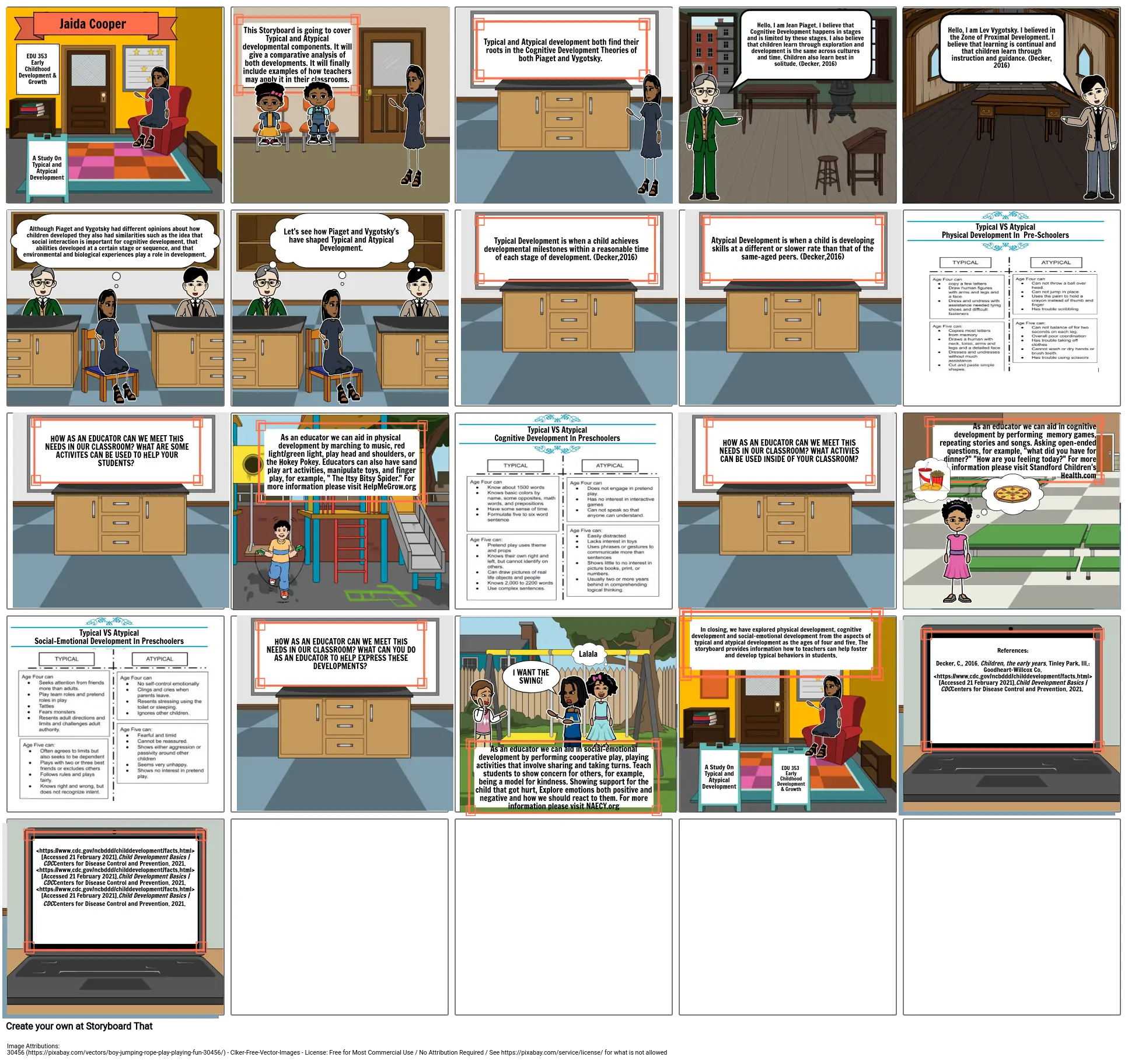Typical and Atypical Assignment

Texto del Guión Gráfico
- Jaida Cooper
- EDU 353 Early Childhood Development & Growth
- A Study On Typical and Atypical Development
- This Storyboard is going to cover Typical and Atypical developmental components. It will give a comparative analysis of both developments. It will finally include examples of how teachers may apply it in their classrooms.
- Typical and Atypical development both find their roots in the Cognitive Development Theories of both Piaget and Vygotsky.
- Hello, I am Jean Piaget. I believe that Cognitive Development happens in stages and is limited by these stages. I also believe that children learn through exploration and development is the same across cultures and time. Children also learn best in solitude. (Decker, 2016)
- Hello, I am Lev Vygotsky. I believed in the Zone of Proximal Development. I believe that learning is continual and that children learn through instruction and guidance. (Decker, 2016)
- Although Piaget and Vygotsky had different opinions about how children developed they also had similarities such as the idea that social interaction is important for cognitive development, that abilities developed at a certain stage or sequence, and that environmental and biological experiences play a role in development.
- Let's see how Piaget and Vygotsky's have shaped Typical and Atypical Development.
- Typical Development is when a child achieves developmental milestones within a reasonable time of each stage of development. (Decker,2016)
- Atypical Development is when a child is developing skills at a different or slower rate than that of the same-aged peers. (Decker,2016)
- Typical VS Atypical Physical Development In Pre-Schoolers
- HOW AS AN EDUCATOR CAN WE MEET THIS NEEDS IN OUR CLASSROOM? WHAT ARE SOME ACTIVITES CAN BE USED TO HELP YOUR STUDENTS?
- As an educator we can aid in physical development by marching to music, red light/green light, play head and shoulders, or the Hokey Pokey. Educators can also have sand play art activities, manipulate toys, and finger play, for example, " The Itsy Bitsy Spider." For more information please visit HelpMeGrow.org
- Typical VS Atypical Cognitive Development In Preschoolers
- In closing, we have explored physical development, cognitive development and social-emotional development from the aspects of typical and atypical development as the ages of four and five. The storyboard provides information how to teachers can help foster and develop typical behaviors in students.
- HOW AS AN EDUCATOR CAN WE MEET THIS NEEDS IN OUR CLASSROOM? WHAT ACTIVIES CAN BE USED INSIDE OF YOUR CLASSROOM?
- As an educator we can aid in cognitive development by performing memory games, repeating stories and songs. Asking open-ended questions, for example, "what did you have for dinner?" "How are you feeling today?" For more information please visit Standford Children's Health.com
- Typical VS Atypical Social-Emotional Development In Preschoolers
- HOW AS AN EDUCATOR CAN WE MEET THIS NEEDS IN OUR CLASSROOM? WHAT CAN YOU DO AS AN EDUCATOR TO HELP EXPRESS THESE DEVELOPMENTS?
- As an educator we can aid in social-emotional development by performing cooperative play, playing activities that involve sharing and taking turns. Teach students to show concern for others, for example, being a model for kindness. Showing support for the child that got hurt, Explore emotions both positive and negative and how we should react to them. For more information please visit NAECY.org
- I WANT THE SWING!
- Lalala
- A Study On Typical and Atypical Development
- EDU 353 Early Childhood Development & Growth
- References:Decker, C., 2016. Children, the early years. Tinley Park, Ill.: Goodheart-Willcox Co.<https://www.cdc.gov/ncbddd/childdevelopment/facts.html> [Accessed 21 February 2021].Child Development Basics | CDCCenters for Disease Control and Prevention. 2021.
- <https://www.cdc.gov/ncbddd/childdevelopment/facts.html> [Accessed 21 February 2021].Child Development Basics | CDCCenters for Disease Control and Prevention. 2021. <https://www.cdc.gov/ncbddd/childdevelopment/facts.html> [Accessed 21 February 2021].Child Development Basics | CDCCenters for Disease Control and Prevention. 2021. <https://www.cdc.gov/ncbddd/childdevelopment/facts.html> [Accessed 21 February 2021].Child Development Basics | CDCCenters for Disease Control and Prevention. 2021.
- Image Attributions:30456 (https://pixabay.com/vectors/boy-jumping-rope-play-playing-fun-30456/) - Clker-Free-Vector-Images - License: Free for Most Commercial Use / No Attribution Required / See https://pixabay.com/service/license/ for what is not allowed
Atribuciones de la Imagen
- 30456 - Clker-Free-Vector-Images - (Licencia Free for Most Commercial Use / No Attribution Required / See https://pixabay.com/service/license/ for what is not allowed )
Más de 30 millones de guiones gráficos creados

